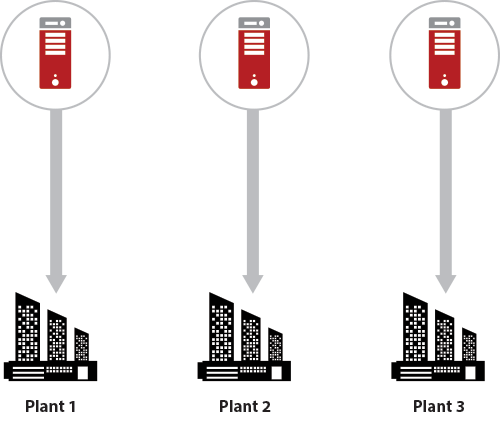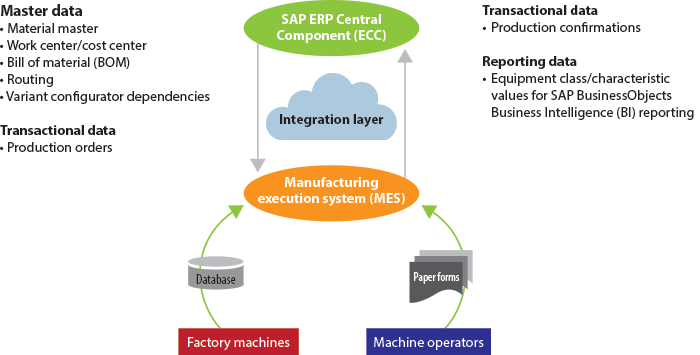Optimize Your Manufacturing Plant by Implementing an MES for Shop Floor Data Collection and Automatic Data Transfer to SAP ECC
A manufacturing execution system (MES) is a critical system in modern manufacturing environments. It controls major shop floor activities such as manufacturing order control, production confirmation tracking, the sequence of routing operation execution, starting and stopping work, and labor time recording. It consumes master data commonly stored in an SAP system that consists of materials, bills of materials (BOMs), work centers, routings, and cost centers. It also offers real-time reporting functionality given its exposure to shop floor data collection not available to other enterprise systems.
(Note: Real-time reporting depends on the connection mode established with manufacturing equipment. If information gathering is enabled in batch mode, reports will experience a delay equivalent to batch job run frequency.)
For many years, SAP did not offer a solution for manufacturing shop floor management and the manufacturing space was left for a system built specifically for this purpose. In the past decade, SAP has released two products, SAP Manufacturing Execution and SAP Manufacturing Integration and Intelligence (SAP MII), both of which are one of today’s market players in the shop floor space (note that SAP Manufacturing Execution and SAP MII are distinct products from SAP ERP Central Component [SAP ECC]). SAP Manufacturing Execution is classified as an MES, while SAP MII is a connector software with dashboarding functionality. I discuss integration between SAP ECC and MES solutions in general, focusing on best practices for system integration.
System Landscape Design
There are two main approaches when designing the technical architecture of an MES system: (1) a central system hosting for all plant locations (Figure 1) and (2) separately hosting an MES system at each plant location. Central hosting is vastly more feasible now compared with a decade ago due to the increased availability of the worldwide high-speed Internet.

However, some manufacturing facilities require no downtime for their MES installations due to the nature of the manufacturing work they conduct. If no MES downtime (that is 100 percent availability) is a true requirement, then the system needs to be hosted locally with redundant servers in place (Figure 2). The design follows a cloud computing methodology.

The Benefit of Planning MES Deployments Using a Standardized System Template
In most MES implementations, the output of the blueprint project phase is an MES deployment template, along with ERP integration specification that includes middleware technology and data objects passed through it. This complex and highly detailed documentation outlines the system design to which all plants need to adhere. Exceptions from the template process need to be thoroughly discussed and scrutinized. In cases of a genuine need for system modification requested by a specific plant, a template deviation process needs to be followed. Once it is complete, I recommend that you evaluate whether any plant-specific functionality can be rolled into an MES deployment template. This method allows packaging plant-specific best practices into the global solution in order to improve MES corporate assets (i.e., propagate manufacturing innovation across the enterprise or introduce cost savings efforts).
Ownership of Data
It is critical to delineate which system owns which business process data early in the blueprint phase, then communicate it across the project and gain consensus. Increasingly, MES systems offer functionality that overlaps with SAP ECC and SAP Advanced Planning and Optimization (SAP APO) applications in certain areas (for example, finite planning and capacity scheduling). Conversely, the SAP ECC system can perform many functions offered by MES vendors (for example, manufacturing order confirmation). Going through this process minimizes risk to the project in the long run, as equivalent functionality that was not selected should be restricted to eliminate business process confusion. The diagram in Figure 3 shows an example of an SAP ERP and MES landscape.

Reviewing Data in the SAP System
To view data relevant to MES implementations in SAP ECC, see Table 1. This table contains data objects most commonly interfaced between SAP and MES. For the Transaction column, create and change transactions for master data objects assumed as part of a regular SAP ECC pattern: 01 – create, 02 – update, 03 – display. If in scope, SAP APO transactions remain the same, as SAP APO is natively interfaced to SAP ECC.
|
Transaction |
Description |
Use cases |
|
MM03 |
View Material Master |
Reviewing material master data (global and plant specific) |
|
CS03 |
View Bill of Material |
Viewing a BOM header and related component materials |
|
CS15 |
Single-Level Where-Used List |
Search where a material component is used in higher level BOMs |
|
CR03 |
Display Work Center |
Display work center data, capacities, and the assigned cost center |
|
CA03 |
View Routing |
View the list of manufacturing operations and associated work centers |
|
C203 |
Display Master recipe |
View manufacturing steps required in order to execute a process order |
|
CO03 |
Display Production Order |
Display a production order and view the associated BOM and routing |
|
COR3 |
Display Process Order |
Display a process order and view the associated BOM and recipe |
|
COOIS |
Production Order Information System |
Search for one or a collection of production orders using a multitude of production order fields |
|
COOISPI |
Process Order Information System |
Search for one or a collection of process orders using a multitude of process order fields |
|
CO11N |
Single Screen Entry of Confirmations |
Display completed production order confirmation quantities |
|
COGI |
Postprocess Faulty Goods Movements |
Display production order confirmations that have failed and see exception messages. |
Table 1
SAP ECC transactions relevant to an MES implementation
Best Implementation Practices
Initially, the most important area of focus is the delineation of functionality between SAP and MES systems. Clear separation of ownership for each system is critical for project success. Next, the system and network landscape needs to be designed by holistically analyzing the needs of all plants that will be candidates for MES deployments in the future. Finally, a detailed blueprint needs to be conducted to evaluate specific system functionality for each business process, along with detailed configuration, functional specification, and integration documentation. From there, the build phase needs to develop a golden client that will serve as a template for all future MES implementations. Finally, a template deviation process needs to be established to handle template exceptions on a plant-by-plant basis.
Avoid Common Implementation Pitfalls
To perform a thorough MES evaluation and match standard functionality to all relevant requirements, it is important to evaluate and rate the level of fit against each captured request. To this extent, all business, engineering, and technology considerations have to be fully addressed before requirement rating and evaluation. Once rated, these items collectively paint a picture of the level of fit with standard MES functionality. This information is used to define a framework that is used to perform MES vendor evaluations in an expedient and productive manner, ultimately driving MES vendor and integrator selection.
There are many business, engineering, and technology considerations during the MES selection, blueprint, and implementation processes. The following list covers major factors that can be of significant impact to an MES project:
- Custom development versus standard configurable MES objects: MES packages differ in the level of configuration that can be performed to mold the system to fit existing manufacturing business processes. Consequently, some MES systems require a change of the existing business processes to allow for system efficiency, and exceptions will require custom development of logic.
- Diverse manufacturing environments: A single manufacturing plant can employ manufacturing techniques used in distinct types of engineering (e.g., discrete and process manufacturing). Additionally, enterprises commonly have manufacturing plants located all over the world, where certain plants specialize in producing materials that are used by the rest of the organization’s supply chain. These considerations should be taken into account during MES template blueprinting, as it makes sense to move highly specialized facilities later in the implementation timeline to allow for faster template deployments and the time to build implementation experience with standardized plant operations.
- MES re-usability: To lower implementation costs, it is critical to promote reusability of MES functionality across plant deployments. This is one of the core reasons for standardization and plant deployments from a central template.
- MES deployment sequence: An MES project timeline development focusing on deployment schedule can be very challenging due to overlapping SAP implementations that are planned and driven by different teams. To that extent, MES can be deployed together with the SAP system or after the SAP system has gone live at a specific plant. Deploying MES in advance of the SAP system is usually not recommended due to the amount of re-work required during the SAP implementation.
- Supplementary MES features: Some MES packages include additional functionality that can benefit the business and serve as a supplement to SAP system features. Examples of this can be detailed employee labor tracking. While these MES features are beneficial overall, additional consideration is needed for extra work required (such as interfacing MES with the SAP HR minimaster).
- Mitigating project risks: As previously mentioned, system ownership delineation is critical to be conducted as part of an MES blueprint, as identical data flows through SAP, MES, and other systems (e.g., material masters, work centers, and cost centers). The SAP system is commonly designated as the system of record for master data due to its size, complexity, and amount of integration coming in and out of it. It is important to understand that defining a system of record does not affect the use of the same data objects by other systems from a design perspective. Specifying sources of truth is a critical method for blueprinting functionality and designing system landscape, while it does not affect how data is processed by different systems.
- Integrating MES with lower level devices: An MES system can communicate with many shop floor devices (such as programmable logic controller [PLC] controllers) through native connections or open database connectivity. The scope of these connections needs to be established and documented during the blueprint phase, as device connectivity can significantly increase deployment scope once the solution is ready for go-live.
- Evaluating extraneous shop floor databases: It is very common to discover custom databases that grew to be critical components of manufacturing operations, yet were developed without the IT department’s knowledge. While very useful to the business, these databases can be significant risk factors due to the lack of associated documentation and scarcity of knowledge to operate them. It is advisable for the implementation team to always evaluate extraneous databases and look for opportunities to replace them with standard MES functionality.
- Technical MES build: Many MES packages allow for options in their design components, such as operative databases. As part of MES evaluation, the design team needs to consider optimal technical solutions while accounting for technology that is already owned by the enterprise. For example, if an enterprise already licenses significant Microsoft SQL or Oracle products, taking this into account when selecting an MES platform can result in significant cost savings.
- Conducting system load tests: In case a plant requirement is for the MES system to have no downtime, it is imperative that thorough load testing be designed and carried out over the same local network in which the MES will be deployed. Alternatively, a network can be built to mimic the network environment in the deployment site, then you can perform load testing. System load tests are most commonly carried out to ensure high data load and transaction frequency will not bring down the MES system.
- Cybersecurity and data recovery: global IT organizations follow the best practice of securing their assets against virtual and physical threats. Consequently, many organizations develop comprehensive procedures and establish processes to handle cyberattacks and major outages due to physical damage to infrastructure assets. As MES systems function as critical components in ensuring basic organizational processes (such as manufacturing) are running, the deployment team should take care to connect with the teams responsible for global information security.
- Eliminating manual and paper-based processes: The value proposition many MES vendors articulate is the significant return on investment through standardization of manufacturing operations, instant data access/reporting, and opening a digital view into manufacturing for the rest of the enterprise. To that extent, many plants have a vision to completely eliminate paper-based forms and processes. Barring minor issues and common-sense processes, the MES implementation team should be aligned with this vision and drive it with each deployment.





